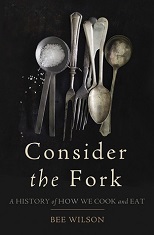![]()
Since prehistory, humans have braved sharp knives, fire, and grindstones to transform raw ingredients into something delicious—or at least edible. Tools shape what we eat, but they have also transformed how we consume, and how we think about, our food.
Technology in the kitchen does not just mean the Pacojets and sous-vide of the modernist kitchen. It can also mean the humbler tools of everyday cooking and eating: a wooden spoon and a skillet, chopsticks and forks.
In Consider the Fork, award-winning food writer Bee Wilson provides a wonderful and witty tour of the evolution of cooking around the world, revealing the hidden history of everyday objects we often take for granted. Knives—perhaps our most important gastronomic tool—predate the discovery of fire, whereas the fork endured centuries of ridicule before gaining widespread acceptance; pots and pans have been around for millennia, while plates are a relatively recent invention.
Many once-new technologies have become essential elements of any well-stocked kitchen—mortars and pestles, serrated knives, stainless steel pots, refrigerators. Others have proved only passing fancies, or were supplanted by better technologies; one would be hard pressed now to find a water-powered egg whisk, a magnet-operated spit roaster, a cider owl, or a turnspit dog. Although many tools have disappeared from the modern kitchen, they have left us with traditions, tastes, and even physical characteristics that we would never have possessed otherwise. (from the publisher)
- Hardcover: 352 pages
- Publisher: Basic Books; First Edition edition (October 2, 2012)
- Language: English
- ISBN-10: 046502176X
- ISBN-13: 978-0465021765



